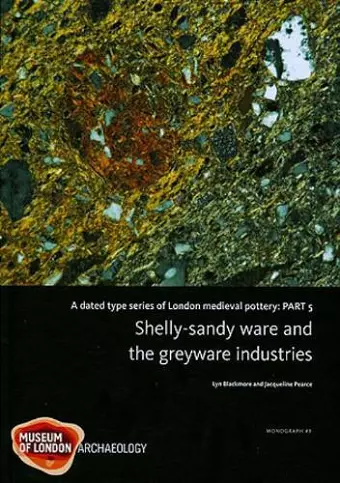A Dated Type Series of London Medieval Pottery, Part 5
Shelly-sandy ware and the greyware industries
Lyn Blackmore author Jacqueline Pearce author
Format:Hardback
Publisher:Museum of London Archaeology
Published:10th Oct '10
Should be back in stock very soon

An essential survey for all interested in the pottery of the London area, this study charts the development, peak and decline of two ceramic traditions: the shelly wares of c 1140–1220, mainly city-based but reaching Scotland and across the North Sea to Norway, and the greywares of c 1170–1350, widely used in the city and even more so in its hinterland. In addition to fabric analyses, form typologies, a gazetteer of find spots and scientific data, the study includes a summary of greyware production centres, and considers function, use, marketing of medieval pottery and the chronology of selected consumer sites in London and its region.
This books title suggests it is not destined for the best-seller table in Waterstones, but it would be a shame if it was only read by pottery enthusiasts... A really informative pottery volume like this one tells us about a good deal more than just ceramics. It gives an insight into commerce both at home and abroad, and the changing economy within which these pottery industries operated.' -- British Archaeology British Archaeology The book charts the development, peak and decline of two types of pottery commonly found in London: the sandy shelly wares of c 1140-1220, produced in or near London and exported up the east coast of Britain to reach Scotland and across the North Sea to Bergen and Trondheim, in Norway; and the greywares of c 1170-1350, one of the first mass-produced medieval ceramics, made in Hertfordshire and Surrey and so widely used in London that scarcely a household lacked a greyware jug or cooking pot.' -- SALON - The Society of Antiquaries Online Newslett SALON - The Society of Antiquaries Online Newslett The immediate relevance of this impressive study may be limited to London, but the story of the medieval city of London that can be told with ever greater precision thanks to meticulous, ongoing archaeological work, of which this book is an excellent example, is crucial to the history of the Middle Ages in all regions.' -- The Medieval Review The Medieval Review
ISBN: 9781901992939
Dimensions: unknown
Weight: unknown
320 pages